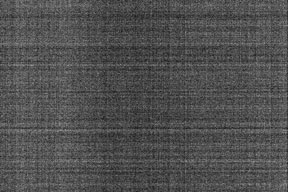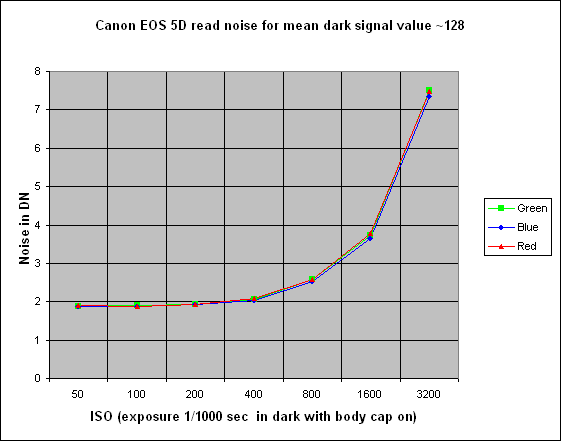Photographs were taken in near total darkness with no lens fitted, with the body cap in place and with the viewfinder eyepiece blocked. A shutter speed of 1/1000 sec was used to minimise thermal noise.
Two shots were taken for each ISO setting. A ten second delay was imposed between shots to avoid any build up of thermal noise due to heating of the sensor or surrounding electronics.

Each image appears to be completely black, because they were shot in the dark. But if we greatly increase the contrast in the image, we will be able to see that there is some slight variation in the numbers recorded. Opposite is the image for the green wells at ISO 100. I have scaled it to 50% in height in order to restore the correct shape.
Some of the variation we are seeing here is caused by fixed imperfections in the camera - that is by imperfections that don't change from shot to shot. Such patterning is simply caused by unevenness in the sensitivity of the sensor wells.
On the other hand, some of the variation we are seeing is caused by random noise, which varies from shot to shot. Such noise is generated in the electronics as we read the charges out of the sensor wells, amplify and offset the voltages, and then digitise them in the analogue-to-digital converter (ADC). The ADC itself generates "quantisation noise" because if the true signal should be digitised as, say, 136.4, it will in fact be digitised as 136 because the ADC can only produce integers. Thus, in this example, an error of -0.4 has been introduced just by digitisation.
We are interested to measure the random noise level rather than the fixed imperfections. We can exclude the fixed imperfections by subtracting one image from another because, by definition, the imperfections are the same in the two images. This is why we took two identical shots at each ISO setting.
After one image has been subtracted from the other, the standard deviation of the result is calculated. The noise is then given by this standard deviation divided by the square root of 2 (to adjust for the fact that noise from both images contributes to the figure).
Statistics for the green, red and blue components for a 200 x 200 pixel area in the centre of the image are shown in the table, together with those of the whole green image:
These figures agree with those obtained by Christian Buil here in section 7.
The noise is plotted in the graph:

The read noise is the same for the three colours. There is a base noise of about 1.88 DN, regardless of ISO, and this compares with 1.73 DN found by Buil.
There is no particular reason for thinking that the read noise would vary according to the colour of the Bayer filter but, as my program produces the figures for each colour, I've put them in the table.
Christian Buil calculated the read noise using a central 300 x 300 pixel crop. The justification for this, I presume, is that the read noise is an input to other measurements that need to use this crop. Since in photography we're interested in the whole frame, I wondered if the full frame figures would be notably different. As can be seen, they aren't, except that the Mean is closer to zero and the Min and Max are more symmetric about zero, as they should be.
It should be noted that I first tried this test with the 24-70mm f/2.8L lens fitted and with its lens cap on. To my surprise, I found that this produced a histogram with a large hole at DN=127, indicating that the 5D firmware reacts differently when a lens is fitted, even though no light is passing through it.
Here is that histogram data at ISO 100:
The offset is 128 DN, as shown below for the green:
We notice in passing that the offset does not seem to change with ISO, thus showing that it is not subject to whatever analogue amplification is applied in order to change the camera's sensitivity. Also, the dispersion of the numbers in the raw file increases with ISO, because this is subject to that amplification.
We also notice, by looking at the Max and Min columns, that there are no zeroes or extremely high numbers in the files. This suggests that if the sensor contains any "dead" or "hot" wells then Canon has marked these and removed them by firmware before writing the raw file.
Peter Facey, Winchester, England
20080129 originated